

El Universo Transmedia de La Peste: La Mano de La Garduña. De la economía de la atención a la economía de la intención. La economía de la atención es aquella que monetiza la atención que presentan los usuarios a los contenidos y es la que ha motivado prácticas como el clickbait.
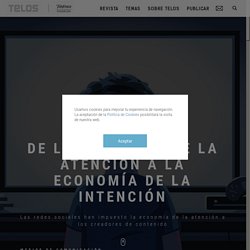
Sin embargo, los creadores de contenidos deben orientar sus esfuerzos hacia un contenido intencional que el usuario busca voluntariamente y no hacia el consumo accidental. Hoy en día los periódicos compiten en las mismas plataformas con los creadores de contenido particulares, las televisiones, los influencers, las marcas. Untitled. As many of you would know, I’ve employed the existing term ‘cross-media’ to refer to a range of practices.
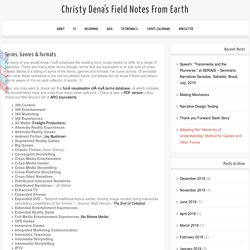
There are many other terms though, terms that are equivalent to or sub-sets of cross-media. Below is a listing of some of the terms, genres and formats I’ve come across. I’ll annotate and credit these sometime in the not too distant future, but please let me know if there are others you’re aware of. I’m an avid collector of words. :0 Also, you may want to check out this fun visualisation of my terms database – which includes the terms listed here and ones from many other artforms. Untitled. Untitled. UX Design Thinking for Transmedia – Scaff Design. “You cannot create experience.
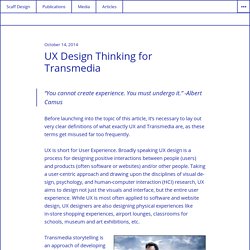
You must undergo it.” -Albert Camus Before launching into the topic of this article, it’s necessary to lay out very clear definitions of what exactly UX and Transmedia are, as these terms get misused far too frequently. UX is short for User Experience. Broadly speaking UX design is a process for designing positive interactions between people (users) and products (often software or websites) and/or other people. Transmedia storytelling is an approach of developing characters and delivering narratives across multiple mediums using both analog and digital technologies. This is the future of entertainment media, the result of the trend of convergence between media in the first decade of the 21st century, driven by many factors including decreasing costs of CGI graphics for films and tv, the explosion of smart phones as primary tools for media consumption, and the electronic gaming industry surpassing the film/tv industry in revenue and popularity. Transmedia Storytelling Tools: Part 1 - Images and Multimedia.
Over the past few year, I've been exploring transmedia and non-linear storytelling.
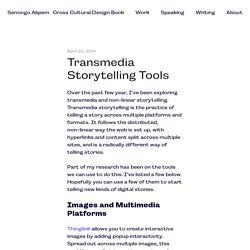
Transmedia storytelling is the practice of telling a story across multiple platforms and formats. It follows the distributed, non-linear way the web is set up, with hyperlinks and content split across multiple sites, and is a radically different way of telling stories. Part of my research has been on the tools we can use to do this. I've listed a few below. Time and Value in the Digital Sphere. Image: Blockchain worm, from McGinn, Birch, et. al., Visualizing Dynamic Bitcoin Transaction Patterns, in Big Data Journal Vol. 4, Nr. 2, 2016 by LF (art historian based in Berlin) The political economy of the free services, like music streams, porn trailers, social media feeds, all this, reshapes the economy of the flows of life into information feeds: it is ever-present tele-vision of commodities.
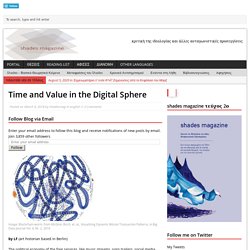
In the end it reshapes our idea of freedom: we do not want to work, we do not want wage, so our activism demands basic income and a world that we do not even want to shape. Also we are seeing the future: we will be all integrated prosumers in the culture industry, creating and remixing and reshaping “content” and mixing it with personal information and feedback. while we run in a gymn we will vote on netflix releases that show cultural interactions and stories that are not our personal history in any way.
The internet is fully developed now, the financialisation of all its content has begun. Transmedia Card Deck. Transmedia Storytelling — Be Unsocial interview (with Enrico Granzotto, Humenhoid) There are numerous inter-sectoral experiments: from the film industry, to sports, from education, to fashion, to the armed forces.
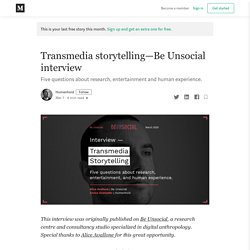
“Principles of New Media” from The Language of New Media by Lev Manovich (2001) PowerPoint Presentation - ID:6087822. “Principles of New Media” from The Language of New Media by Lev Manovich (2001) Purpose • To identify some of the key differences between old and new media5 Principles • Numerical Representation • All new media is made of numeric (digital) codes • New media described mathematically – image or shape • Subject to algorithmic manipulation • Industrial Revolution – discrete units; factory systems2.
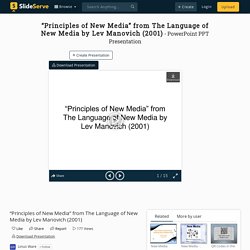
Modularity • Media elements are independent of one another, but come together to form a greater object • Image in word document • QuickTime movie • HTML doc – GIF, JPEG • www • Structural computer programming – will not work if delete a module3. Automation • Due to digital code and modular structure, media creation can be automated • Low-level automation – modification by computer user • High-level automation – modification by computer • Photograph – Film vs. digital4. Press, Pause, Play [Sub. Español] El Centro: Latinoamérica – Armadillo: New Media & Films. Viaje impredecible de un usuario imaginario. Introducción al concepto de #Transmedia (I) Durante los años 2010 a 2012, el concepto de “transmedia” estaba a full.
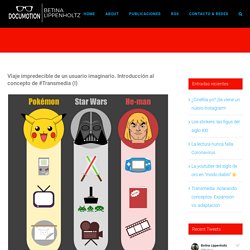
42 Entertainment. Biophilia, el álbum transmedia de Bjork sobre el cosmos. X Media Lab – for Smart, Data-Driven, Augmented, Creative People. Untitled. Untitled. I find the potential of Transmedia Storytelling to intrinsically motivate literacy engagement in the classroom astounding.
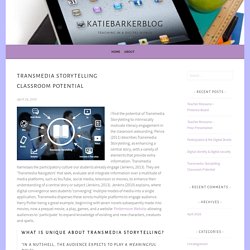
Definitive Guide to Transmedia Storytelling - AT&T SHAPE Blog. Stories are an innate human need.
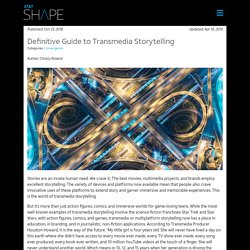
We crave it. The best movies, multimedia projects, and brands employ excellent storytelling. - Welcome to Pine Point. Webinar: Invertir el aula como estrategia de innovación educati. Narrative – 7 Basic Plots/ 7 Basic Characters – themediastudentsblog. There are 7 basic plots: Overcoming the MonsterRags to RichesThe QuestVoyage and ReturnComedyTragedyRebirth (Booker, C (2004) The Seven Basic Plots: Why We Tell Stories) See below for some examples: Vladimir Propp’s Theory of Narrative – Morphology of the Folktale and Scholar Soviet folklorist and scholar (born 1895), Propp developed a theory for studying media texts and productions.His theory explains 7 broad character types.The Villain (struggles against hero)The Donor (prepare the hero or gives hero a magical object)The (magical) Helper (helps hero in the quest)The Princess or the Prize (person the hero marries, goal often sought for during narrative)The False Hero (perceived as good character at start, but emerges as evil)The Dispatcher (teachers and guides hero)The Hero (central protagonist, goes on quest, weds the princess) See the image below for some examples, excuse the mistakes, I found the table on the internet:
Principles of Transmedia. Jump To: Previous Page: “What is Transmedia Storytelling?” Spreadability | DrillabilityContinuity | MultiplicityImmersion | ExtractabilityWorldbuilding | SerialitySubjectivity | Performance Next page: How Games and Networks Tell Stories Only a few months before the Producers Guild sanctioned the role of transmedia producer, Henry Jenkins, the professor who was among the first scholars to define transmedia, assembled a list of “seven principles of transmedia storytelling” in a pair of late-2009 blog posts. In them Jenkins fleshed out concepts introduced first in a column for Technology Review, then in his notable book Convergence Culture: Where Old and New Media Collide. Jenkins then establishes his seven principles: Spreadability vs. Drillability, Continuity vs. With Spreadability stories are spread through fan interaction. The USB flash drive found in a concert venue bathroom for the Nine Inch Nails Year Zero tour.
Del transmedia como género a cómo el cerebro come historias como si fuesen caramelos Teórico 7 (8/5/2012) Corsi e ricorsi en el abordaje de los transmedia A lo largo de varias semanas hemos ido avanzando pausadamente en una caracterización del mundo transmediático y en particular de las ficciones transmediáticas (para la no ficción transmediática ver los recientes posts de Carlos Scolari como Más allá de la ficción: el documental transmedia). La problemática es compleja y necesita de una conversión epistemológica por parte de quienes quieren jugar a este nuevo juego del consumo transmediático, pero sobretodo de la producción transmediática. Untitled. Drawing on MIT’s legacy of media innovation and its deep commitment to open and accessible information, the MIT Open Documentary Lab brings storytellers, technologists, and scholars together to explore new documentary forms with a particular focus on collaborative and interactive storytelling.
The Lab understands documentary as a project rather than as a genre bound to a particular medium. In the spirit of MIT’s open courseware and open source software movements, the Open Documentary Lab is collaborative and committed to sharing knowledge, networks, and tools. The Lab is catalyst, partner and guide to the future of reality-based storytelling. Henry Jenkins defines transmedia storytelling as “a process where integral elements of a fiction get dispersed systematically across multiple delivery channels for the purpose of creating a unified and coordinated entertainment experience.
Ideally, each medium makes it own unique contribution to the unfolding of the story.” Untitled. Lo aprendí en un tutorial. Fotos: Carlos Scolari El chico regresa de la escuela, saluda con una mueca, picotea algo al vuelo y se encierra en su habitación. Transmedia Literacy. General dissemination Project Documents (public deliverables) Transmedia Literacy.